
Malawi’s dairy sector is facing significant challenges as milk producers decry the low prices of milk and the rising imports of milk powder. These factors are impeding the growth of the dairy industry in the country, according to the Malawi Milk Producers Association.
On World Milk Producers Day, celebrated on June 1, 2023, the association voiced its concerns about the state of the industry. Herbert Chagona, the Executive Director of the Malawi Milk Producers Association, emphasized the need to address the situation and regulate milk powder imports.
Chagona stated, “We need more off-takers in the industry. We also have no regulatory body in the milk industry. Liquid milk cannot meet the demand the country needs.”
Milk producer Mike Phiri added that farmers are facing additional challenges, including a 3% withholding tax, which is pushing them to sell their milk through informal channels.
Data from the Malawi Milk Producers Association reveals that milk prices in Malawi remain the lowest in the region, with prices as low as K260 (approximately 26 cents) per litre.
Phiri further explained, “We need to supplement the supply with powdered milk. All we are asking is to control the flow of powdered milk so that it does not crowd out the local milk production and the markets, considering that some companies under Malawi Revenue Authority rebate are repacking the milk into small sachets as small as 20 grammes.”
Earlier this year, the association raised concerns about the increasing cost of milk production, which had risen by 36% from MK148 ($0.15) to MK202 ($0.20).
This rise was attributed to several factors, including the increase in maize prices (as dairy cattle are fed maize husks as animal feed), the depreciation of the Kwacha since May 2022, and the need to purchase fuel for generators due to electricity load-shedding.
The association highlighted the substantial increase in the price of maize, which is a crucial component of dairy cattle feed. A 50kg bag of maize has nearly doubled in price, reaching around MK13,500, compared to MK6,500 in early 2022. These high prices are expected to persist for several months.
In 2022, Malawi’s dairy sector produced 65 million litres of milk, up from 57.6 million litres the previous year. The sector directly supports 25,000 dairy farming households and employs over 6,000 people, excluding the farmers themselves. The annual revenue generated from the dairy sector amounts to approximately K16.9 billion.
Despite the progress made, the quantity of milk produced is insufficient to meet the country’s demand. Malawians consume only 10 litres of milk per person per year, which is the lowest consumption rate in Africa. The Food and Agriculture Organization reports that the average milk consumption per capita in Africa is 20 litres.
The Department of Agriculture and Animal Health in Malawi estimates that the country has 82,000 dairy cows, with an average of two cows per farmer.
To address the challenges faced by the dairy sector, it is crucial to take measures to stabilize milk prices, control milk powder imports, and provide support to farmers. Implementing regulations and establishing a regulatory body for the milk industry can ensure fair pricing and market stability. Additionally, supporting farmers by providing access to affordable animal feed and addressing electricity shortages can contribute to the growth and sustainability of Malawi’s dairy sector.
Stay updated with the latest farming tips and agriculture industry news from Africa by subscribing to our newsletter. Don’t miss out on valuable insights and updates. Follow us on Twitter, LinkedIn, and Facebook to join our farming community and stay connected with us.



















Leave a Reply